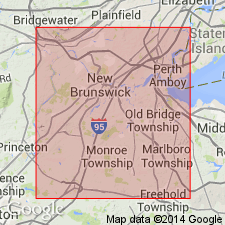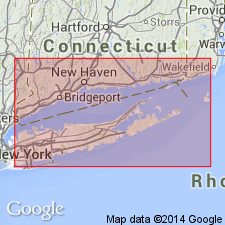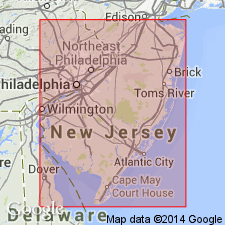
- Usage in publication:
-
- South Amboy fire clay
- Modifications:
-
- First used
- Dominant lithology:
-
- Clay
- AAPG geologic province:
-
- Atlantic Coast basin
Summary:
South Amboy fire clay is economic term for a clay bed, 5 to 30 ft thick, in the Raritan formation of northeast NJ.
Source: GNU records (USGS DDS-6; Reston GNULEX).

- Usage in publication:
-
- South Amboy fire clay
- Modifications:
-
- Overview
- AAPG geologic province:
-
- Atlantic Coast basin
Summary:
Thickness of South Amboy fire clay of Raritan formation as much as 25 ft along outcrop. Overlies Sayreville sand member (new) and underlies Old Bridge sand member (new). Age is Cretaceous.
Source: GNU records (USGS DDS-6; Reston GNULEX).

- Usage in publication:
-
- South Amboy Fire Clay Member*
- Modifications:
-
- Age modified
- AAPG geologic province:
-
- Atlantic Coast basin
Summary:
South Amboy fire clay of Cook and Smock (1877) adopted as South Amboy Fire Clay Member of Raritan Formation. Overlies Sayreville Sand Member of Raritan; underlies Old Bridge Sand Member of Magothy Formation. Age is Late Cretaceous (middle Cenomanian).
Source: GNU records (USGS DDS-6; Reston GNULEX).

- Usage in publication:
-
- South Amboy Fire Clay Member*
- Modifications:
-
- Revised
- AAPG geologic province:
-
- Atlantic Coast basin
Summary:
The South Amboy Fire Clay Member in NJ is removed from the Raritan Formation and is considered the lowest member of the Magothy Formation. Consists of dark, massive to finely laminated clay with interbedded fine- to medium-grained, cross-bedded sand. Commonly occurs in large channels. Overlies the Raritan Formation and underlies the Old Bridge Sand Member of the Magothy.
Source: GNU records (USGS DDS-6; Reston GNULEX).
For more information, please contact Nancy Stamm, Geologic Names Committee Secretary.
Asterisk (*) indicates published by U.S. Geological Survey authors.
"No current usage" (†) implies that a name has been abandoned or has fallen into disuse. Former usage and, if known, replacement name given in parentheses ( ).
Slash (/) indicates name conflicts with nomenclatural guidelines (CSN, 1933; ACSN, 1961, 1970; NACSN, 1983, 2005, 2021). May be explained within brackets ([ ]).

